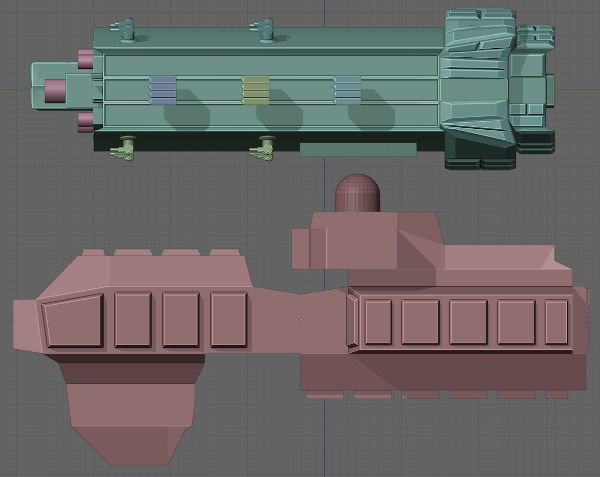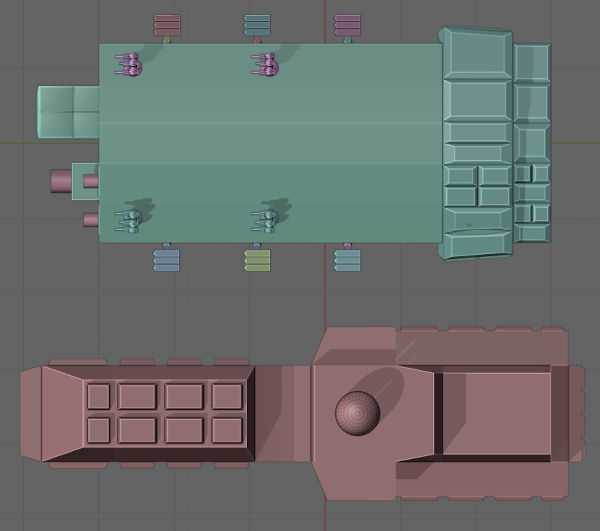Starship Combat

This is an attempt to play through the starship combat rules for Mongoose Traveller, using the scenario that occurred ‘off screen’ in the previous session. I’m trying out two very rough warship designs, as well as learning the rules, to try and see how things would have played out if I’d actually used the rules rather than simply deciding the narrative for story purposes. So I’m bound to get things wrong, or skip over some bits for simplicity.
The situation opens with the KSS Eiserne Stärke approaching the Peace of Nations beyond the jump limit of Berlichingen, and ordering it to shutdown its engines and prepare to be boarded. The Peace of Nations requests aid from the SNS Cambridge which is currently in orbit around the world.
In basic stats, the two warships are similar, with the Cambridge being slightly larger at 1,600t compared to the Eiserne Stärke’s 1,400t. The latter actually looks larger in a side view, as shown below, but is thinner.

Note that the blender model for the Cambridge is much more detailed than that of the Stärke, which doesn’t yet show any weapon turrets or other details.
The skills of the various ships are as follows. I generated the skills randomly, so not sure how reasonable they are for military vessels. I expect that they’d normally be higher, so we can assume that the crew of both ships are relatively green.
Cambridge
Pilot-3, Tactics-4, Sensors-2, Gunnery-2
Eiserne Stärke
Pilot-2, Tactics-4, Sensors-3, Gunnery-1
Peace of Nations
Pilot-3, Sensors-0, Gunnery-0
Distant Range
As the Eisen Stärke locks onto the Peace of Nations and fires some warning shots with beam lasers, the Cambridge launches a salvo of 6 missiles. They could have launched 18, but this is more of a warning shot and there’s a friendly close to the target.
Since it’s at extreme range, it’ll take 10 rounds for the missiles to reach their target. That’s plenty of time for the Eisen Stärke to use multiple electronic warfare checks to render the missiles useless. In narrative terms, the Eisen Stärke is able to use the Peace of Nations as cover, forcing the Cambridge to abort the attack.
The Eisern Stärke will return fire during this time, firing three different salvos over three rounds. It only has two (triple) missile turrets, so can fire 6 missiles a turn – for a total of 18 missiles.
The Cambridge has a slightly inferior electronic warfare team, and only take out a single missile, so the Cambridge receives 5 missiles in the first round, followed by two rounds of 6.
Their point defence is exceptional though – the Cambridge has 8 double beam turrets, each of which +5 to hit against missiles, plus a gunnery skill of 2 means all missiles are easily shot down. Possibly the Cambridge has an overabundance of point defence systems (but the crew aren’t complaining).
High Guard has a rule that the size of missile salvos are halved every 5 rounds, so all attacks would have been much less effective if I’d noticed that beforehand.
They’ve had 10 rounds of combat so far. It takes 50 thrust to close from Distant to Very Long range, and with a thrust of 3 the Cambridge has only moved 30. Meanwhile, the Peace of Nations has accelerated a total of 10 towards the planet (and the Cambridge), so that’s a total of 40. The Eisen Stärke is keeping pace with its target having closed to adjacent, using it as cover but given up on its attempt to board.
After another three rounds, the ships enter Very Long range of each other.

Very Long Range
At this point the Cambridge opens up with its Particle Beam Bay. This has a -4 penalty due to range, and -2 for attacking a target less than 2,000t in size. Using the computer’s fire control software, they do get a +4 on top of the gunner’s skill of 2, for a total DM of +0. They get a 5, and miss.
At this point the Eisern Stärke is now out-ranged, so decides to try and close the range as quickly as possible, breaking away from the Peace of Nations and accelerating towards the Cambridge with Thrust 2. It also fires a salvo of 6 missiles again. This allows the civilian vessel to break away, increasing range to Short.
With the Peace of Nations in the clear, the Cambridge fires a full salvo of 18 missiles, and tries to hit with its particle beam again – getting a 9 which hits. Since the Eisen Stärke is trying to close range, it doesn’t have any Thrust left to dodge, so is hit – taking 28 points of damage. It’s armour reduces this to 16.
Eisern Stärke HULL: 600/616
The Cambridge fails to block any missiles, and the Eisern Stärke fires another 6 but also fails to block any. There is now 3 rounds before the first salvo reaches the Cambridge.

The Cambridge stops accelerating – it now wants to keep the distance, but also wants to encourage the enemy to continue to move away from its civilian shield. The Stärke continues its approach.
There’s a second hit with a particle beam, for 33 damage, and another salvo of 18 missiles. During this time, the Cambridge is ordering the Stärke to back away and cease hostilities, which it is refusing to do so.
Eisern Stärke HULL: 579/616
The Stärke can only try to jam the missiles – succeeding in taking down 3 of them, leaving 15 in the first salvo. The Cambridge is not having much luck using electronic warfare, but it’s not too bothered by that.
Next round, the Cambridge is still coasting, and the Stärke is accelerating to close the range.
The rules don’t use proper Newtonian motion – you have to actively thrust to close range, when in reality if the Cambridge had been thrusting at 3 for 12 rounds, it would be moving at 36 each round by now, so would be needing to decelerate to keep the distance. Proper movement is important to me, so I might have a think about whether I want to change this.
The Cambridge opens up with its particle beam, missing, but fires a third full salvo of missiles. The Eisern Stärke jams another missile from the first salvo – down to 14 and launches another missile salvo.
The distance is now down to 14 until they enter Long range, and they continue their movement as before.
The first salvo of missiles strikes at the Cambridge, but it shoots them all down with its point defence. It gets a particle beam hit, doing another 35 points of damage. It doesn’t fire another salvo of missiles – waiting to see what effect the first salvo has.
Eisern Stärke HULL: 556/616
This is the round that a large salvo of missiles will hit the Eisern Stärke, and I’m interested to see how effective it will be, since I have absolutely no idea.
There are 14 missiles coming in, and two triple (+2) beam (+4) turrets being used for point defence. The first shoots down 7 missiles, and the second 6 missiles, leaving one. The pilot is also dodging, giving a DM of -2 – the end result is that the remaining missile misses. So not as effective as I was thinking.
The missiles that reach the Cambridge are taken down by point defence fire, and it uses its particle beam, doing another 31 points of damage.
Eisern Stärke HULL: 537/616
This takes the Stärke below 90% of its hull, so takes a critical hit to its armour, reducing it to 11.
The next round, 18 missiles reach their target, but 12 are shot down. The attack roll is 11, and pilot’s dodging means two miss. A single missile hits and does only 5 damage – not even getting through the armour.
The third salvo from the Cambridge also attacks with 18 missiles, of which 11 are shot down, and the effect, after the pilot’s dodging, is 6. The damage roll this time is a 19 – reduced to 8 for armour, for a total of 48 damage. Much more effective.
Eisern Stärke HULL: 489/616
The effect of 6 means there is a severity 5 critical hit, hitting the jump drive and destroying it. It also does a +1 Hull Severity, which I assume means any future Hull criticals are at +1 severity.
There is also another Hull Point critical, damaging the M-Drive (checks to control at DM-1).
So by now the Eisern Stärke is taking significant damage, with no damage to the Cambridge. Missiles can be effective, though its relatively easy to have enough point defence to render them useless. I have wondered whether I should allow the Stärke to launch missiles slowly, to time attacks over several rounds so they all arrive at the same time on the target in one big salvo. The Cambridge would also be able to do this though, and I can see this maybe being too effective.
The Cambridge demands the surrender of the KSS Eisern Stärke, but it refuses. The pause does provide enough time for the range to close to Long, bringing the ships to a range where the Stärke can start fighting back. It would have been more tactical of the Cambridge to either destroy the enemy before this happened, or to keep the range open, but there was a narrative issue in that the Cambridge needed to come out of this damaged. So the captain made a tactical mistake.
Long Range
By now the Stärke is wanting to close the range to Medium so that it can use its Fusion Barbettes, so just accelerates towards the Cambridge.
The Cambridge opens up with a missile salvo, and they are now close enough that it will hit next round. Their sensor operator manages to get an improved sensor lock on the Stärke, giving any attacks a Boon to hit. This is something they should have been doing earlier, but I only just saw the rule for this.
The particle beam attack gets a 12, doing 38 damage. Since there aren’t any incoming missiles at the moment, the beam batteries also open up, but they mostly bounce off the Stärke’s armour, doing a total of 2 damage after armour. However, that one hit got an effect of 8, so is a critical.
Eisern Stärke HULL: 460/616
The M-Drive is hit again, reducing it down to 1 Thrust and meaning piloting checks are at -2.
The Eisern Stärke fires its own beam weapons, ineffectively, and also fires another missile salvo. The missiles don’t do any damage, but they keep the beam turrets of the Cambridge occupied with point defence.
The Stärke shoots down most of the missiles next round, but takes particle beam damage of 28. The following round, it is less lucky, getting a 10 and 9 on its point defence checks, only destroying 3 missiles.
The missile attack has an effect of 15, doing 15 damage, which is reduced by armour to 4 points per missile – 60 points, and a severity 6 critical to the Crew. Life support systems fail immediately. I’m not entirely certain what that means – it doesn’t say that it’s instant death for everyone, so I assume that it’s not. Instead, oxygen recycling will stop, as will temperature control. They’ve probably got time to reach the life pods.
Eisen Stärke HULL: 400/616
Dropping down another 10% boundary gives a Fuel critical, which is a fuel leak losing fuel at 1d6t per hour.
A particle beam hit does 31 damage, but no critical.
Eisern Stärke HULL: 380/616
Concluding the Fight
From a rules perspective, the KSS Eisern Stärke is completely outmatched by the SNS Cambridge. The latter has longer range weapons, higher thrust to enable it to control the range of the battle, and has a more effective combination of weapons.
It has six triple missile turrets, a decision based simply on that fact that three turrets along each side of the ship looked cool. It also has a number number of weapons that can be used in point defence, meaning it’s not vulnerable to smaller missile salvos.
The Stärke in contrast is more suited to close in combat, and has a range of different weapon types – which gives it both smaller missile salvos and fewer defences against them.
Given that, the Stärke should surrender or flee – it probably should have done that a long time ago. I don’t see this fight going in any direction other than the destruction of the Neubayern vessel. Presumably this is the first time there’s been an actual shooting match between the two nations for a while.
For narrative purposes, I’m assuming that several of the Stärke’s missiles got through and damaged the Cambridge, taking out its fuel scoops or fuel processors at the very least, preventing it from jumping.
Having seen how the two designs played out, I’m probably going to update the design of the Pola class. Given it has short range weapons, it should probably have much higher thrust to enable it to control the engagement range. As a frigate, it’s designed for civilian escort duties and an anti-pirate role, not to go up against full warships.
The Freemantle class is better designed to take on larger ships, and can probably remain as is. I need to read through more of the options on software packages, and also combat options for electronic warfare.
I also need to think about whether to keep the range bands, or go for something more tactical. I prefer the latter conceptually, since I’m very much in favour of Newtonian movement for space combat. It would complicate things though, so I’d need to figure out how best to implement it in something like Roll20.
It was interesting to see how different the actual battle turned out with the given ship designs though. Long range weapons are highly effective, and missiles can be as well if the salvos are large enough. Small missile salvos are very easy to stop.